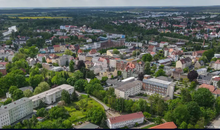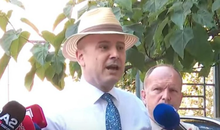
 Flash News
Flash News
Drenova prison police officer arrested for bringing drugs and illegal items into cell
Lavrov: NATO is risking self-destruction with new military budget
Kurti and Vučić "face off" tomorrow in Skopje
Construction worker dies after falling from scaffolding in Berat
The prosecution sends two Korça Municipality officials to trial
Illyrian archaeological discoveries in Koroshishte of Struga / The institutions of North Macedonia distort the truth

In an extraordinary archaeological discovery in Struga, an ancient helmet has been found, which is thought to belong to the Illyrian tribe of the Enkeleites and dates back over 2,500 years.
Helmets of this type, known as "Corinthian helmets", were used in Southern Illyria, especially by the well-known historical figure, King Pyrrhus of Epirus. This discovery, along with other important artifacts such as bronze and gold pottery found in the royal tomb, has reverberated throughout the region for its historical and cultural value.
But the Macedonian media and the Ministry of Culture of North Macedonia are trying not to connect these archeological findings with the Illyrian period, but are trying to sell the event as if they were found in a village in North Macedonia, that is, not in Albanian territory.
Fiksi traveled to the village of Koroshisht in Struga to see the excavations being done up close. Upon arrival, the group was informed that the work was finished and that the field in which the archaeological artifacts were found had returned to its previous state.
Fiksi contacted the owner of the land where the excavations took place, Mr. Chief Shemshedin, who told Fiks how he had found these artifacts. Initially, while working the soil with a pickaxe in 2020, he had found the first helmet. "Then I came across some stones and it was difficult to dig, so I took an excavator and then we found the bronze helmet, which we took to the museum of Ohrid," says Shemshedini.
After 4 years, a group of archaeologists showed interest and went to his property, where they asked him for permission to do specialized excavations.
But from 2020 to 2023, no one bothered to declare the area an archaeological area.
In order to better understand the significance of the artifacts found, Fiksi also met the Albanian archaeologist Fitni Dalipi. Mr. Dalipi has joined the group of Macedonian archaeologists since the first day of excavations. Dalipi says that some things were found in this area, such as needles, a helmet, pieces of gold. Even they, as archaeologists, think that there they can find the ruins of a civilization that belongs to the 6th century BC. These artifacts belong to the Illyrian Enkelej tribe, who lived in the regions around Lake Ohrid and who created the first dynasty of the Illyrian kingdom at the end of the 5th century BC. Meanwhile, Macedonian archaeologists do not want to accept this fact.
Fiksi also contacted the deputy mayor of Koroshisht village, Mr. Xhemil Alla, who declared that the entire village and residents are ready to make their lands available to archaeologists. This is because they feel very lucky that Illyrian artifacts have been found in their lands. "This proves the antiquity of the Albanian people in these lands," says Vice President Alla.
But another thing is written and said in the media of the neighboring country, who are struggling with disinformation, giving another connotation to the archaeological findings. the first thing the Macedonian media do is that they have changed the location of these archaeological finds, removing them from settlements with Albanian population and informing that the excavations were done in the village of Volinë. The village with a Macedonian population that is separated from the village of Koroshishte by only one bridge. The village of Koroshishte has over 90% of the Albanian population and lies to the northeast of Struga.
What raises even more doubts to distort the truth of the origin of these archaeological artifacts, is that the Macedonian archaeologist Pasko Kuzman is also seen in the group of archaeologists. The latter was sentenced in 2014 by the Criminal Court in Skopje to three years in prison for illegal excavation and sale of archaeological objects.
Even in the official reaction of the Minister of Culture of North Macedonia, not a single word says that these artifacts belong to the Illyrian period. In response, the minister only asserted that these archaeological findings belong to the sixth century before our era and represent an archaic necropolis./Top Channel
Latest news



Second hearing on the protected areas law, Zhupa: Unconstitutional and dangerous
2025-06-30 22:18:46



Israel-Iran conflict, Bushati: Albanians should be concerned
2025-06-30 21:32:42

Fuga: Journalism in Albania today in severe crisis
2025-06-30 21:07:11
"There is no room for panic"/ Moore: Serbia does not dare to attack Kosovo!
2025-06-30 20:49:53

Temperatures above 40 degrees, France closes nuclear plants and schools
2025-06-30 20:28:42
Lavrov: NATO is risking self-destruction with new military budget
2025-06-30 20:13:54
Turkey against the "Bektashi state" in Albania: Give up this idea!
2025-06-30 20:03:24

Accused of sexual abuse, producer Diddy awaits court decision
2025-06-30 19:40:44



Kurti and Vučić "face off" tomorrow in Skopje
2025-06-30 18:44:12
Tourism: new season, old problems
2025-06-30 18:27:23


Construction worker dies after falling from scaffolding in Berat
2025-06-30 17:51:44




Almost free housing: East Germany against depopulation
2025-06-30 16:43:06

Hamas says nearly 60 people killed in Gaza as Trump calls for ceasefire
2025-06-30 16:14:15
Drownings on beaches/ Expert Softa: Negligence and incompetence by institutions!
2025-06-30 16:00:03


European ports are overloaded due to Trump tariffs
2025-06-30 15:30:44
The prosecution sends two Korça Municipality officials to trial
2025-06-30 15:19:54

Lezha/ Police impose 3165 administrative measures, handcuff 19 drivers
2025-06-30 14:55:04
Young people leave Albania in search of a more sustainable future
2025-06-30 14:47:52
Record-breaking summer, health threats and preventive measures
2025-06-30 14:36:19


Constitution of the Parliament, Osmani invites political leaders to a meeting
2025-06-30 14:07:54

Heat wave 'invades' Europe, Spain records temperatures up to 46 degrees Celsius
2025-06-30 13:42:02
Accident in Vlora, car hits 2 tourists
2025-06-30 13:32:16

Kurti confirms participation in today's official dinner in Skopje
2025-06-30 13:03:27

Fight between 4 minors in Kosovo, one of them injured with a knife
2025-06-30 12:38:45

Report: Teenage girls the loneliest in the world
2025-06-30 12:20:40
Commissioner Kos and Balkan leaders meet in Skopje on Growth Plan
2025-06-30 12:07:59
Wanted by Italy, member of a criminal organization captured in Fier
2025-06-30 11:55:53
Hundreds of families displaced by wave of Israeli airstrikes in Gaza
2025-06-30 11:45:17

Zenel Beshi: The criminal who even 50 convictions won't move from Britain
2025-06-30 11:23:19
A new variant of Covid will circulate during the summer, here are the symptoms
2025-06-30 11:14:58


"Partizani" case, trial postponed to July 21 at the Special Court
2025-06-30 10:41:05
Uncontrolled desire to steal, what is kleptomania, why is it caused
2025-06-30 10:30:08
Requested change of security measure, hearing for Malltez postponed to July 7
2025-06-30 10:24:32


Output per working hour in Albania 35% lower than the regional average
2025-06-30 09:54:35


The trial for the "Partizani" file begins today
2025-06-30 09:27:57
22 fires in the last 24 hours in the country, 2 still active
2025-06-30 09:21:28
How is the media controlled? The 'Rama' case and government propaganda
2025-06-30 09:13:36
German top diplomat: Putin wants Ukraine to capitulate
2025-06-30 09:00:07
Foreign exchange, how much foreign currencies are sold and bought today
2025-06-30 08:44:38
Chart/ Sovereign risk for Albania from international markets drops significantly
2025-06-30 08:26:38
Horoscope, what do the stars have in store for you?
2025-06-30 08:11:44
Clear weather and passing clouds, here is the forecast for this Monday
2025-06-30 07:59:32
Morning Post/ In 2 lines: What mattered yesterday in Albania
2025-06-30 07:47:37
Milan make official two departures in attack
2025-06-29 21:57:23
6 record tone
2025-06-29 21:30:46
4-year-old girl falls from balcony in Lezha, urgently taken to Trauma
2025-06-29 21:09:58


Assets worth 12 million euros seized from cocaine trafficking organization
2025-06-29 19:39:43
Fire in Durrës, Blushi: The state exists only on paper
2025-06-29 19:17:48

Fire endangers homes in Vlora, helicopter intervention begins
2025-06-29 18:27:51
France implements smoking ban on beaches and parks
2025-06-29 18:02:08
England U-21 beat Germany to become European champions
2025-06-29 17:42:49
Trump criticizes Israeli prosecutors over Netanyahu's corruption trial
2025-06-29 17:08:10
Street market in Durrës engulfed in flames
2025-06-29 16:52:57

UN nuclear chief: Iran could resume uranium enrichment within months
2025-06-29 16:03:24
Albanian man dies after falling from cliff while climbing mountain in Italy
2025-06-29 15:52:01

Another accident with a single-track vehicle in Tirana, a car hits a 17-year-old
2025-06-29 15:07:15
While bathing in the sea, a vacationer in Durrës dies
2025-06-29 14:54:01
Sentenced to life imprisonment, cell phone found in Laert Haxhiu's cell
2025-06-29 14:26:40
77 people detained in protest, Vučić warns of new arrests
2025-06-29 14:07:46

